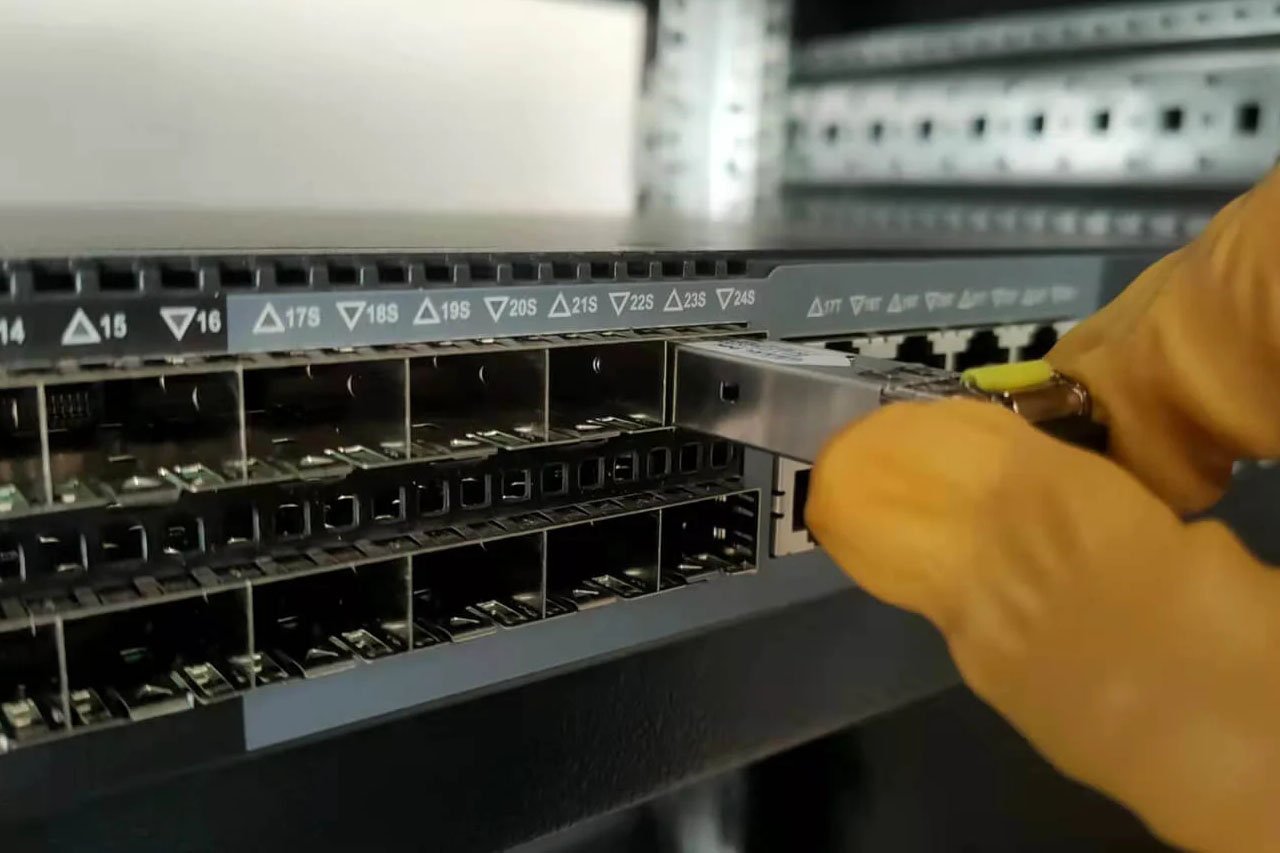SFP (Small Form-factor Pluggable) is a compact, hot-swappable optical transceiver module used for physical connections between network equipment (such as switches, routers, and servers) and fiber optic or copper cables. The term “Small Form-factor” reflects its compact size (approximately 21mm×14mm×56mm), while “Pluggable” refers to its hot-swappable capability, allowing module replacement without powering down the device.
The standardization of SFP is driven by the international organization MSA (Multi-Source Agreement), ensuring compatibility in dimensions, electrical interfaces, and communication protocols across modules produced by different manufacturers. This standardized design breaks the closed nature of traditional optical transceivers, significantly reducing network deployment and maintenance costs.
2. Technical Features of SFP Modules
Flexibility and Compatibility
SFP modules support multiple transmission media (single-mode fiber, multi-mode fiber, copper cables) and communication protocols (such as Ethernet, Fiber Channel, SONET/SDH). They can be selected based on requirements for different wavelengths (850nm, 1310nm, 1550nm, etc.) and transmission distances (ranging from a few hundred meters to over a hundred kilometers). Examples include:
– 1000BASE-SX: Multi-mode fiber, transmission distance of 550 meters;
– 1000BASE-LX: Single-mode fiber, transmission distance of 10 kilometers;
– 1000BASE-T: Twisted pair, transmission distance of 100 meters.
Hot-swappable Functionality
Modules can be inserted or removed while the device is running, eliminating the need to interrupt network services and greatly improving maintenance efficiency.
Low Power Consumption and High Density
Compared to earlier GBIC modules, SFP modules are half the size and consume less power (typically under 1W), allowing for higher port density in network equipment within limited space.
Intelligent Management
Supports DDM (Digital Diagnostic Monitoring) functionality, enabling real-time monitoring of parameters such as temperature, optical power, and voltage for easier fault diagnosis and performance optimization.
3. Development History of SFP Modules
Predecessor: GBIC Modules
Before the advent of SFP, GBIC (Gigabit Interface Converter) was the mainstream gigabit-level optical transceiver, but its larger size (approximately twice that of SFP) limited port density in devices.
Birth and Evolution of SFP
– 2001: SFP standard released, quickly replacing GBIC as the mainstream solution;
– 2006: SFP+ introduced, supporting 10Gbps speeds;
– Subsequent Developments: To meet higher bandwidth demands, derived modules such as QSFP (Quad SFP, supporting 40G/100G) emerged, though SFP remains dominant in medium- to low-speed scenarios.
4. Application Scenarios of SFP Modules
Data Centers
Used for high-speed interconnections between servers and switches, supporting high-bandwidth requirements for virtualization, cloud computing, and other services.
Telecommunications Networks
Employed for signal relay and long-distance transmission in metropolitan area networks (MANs) and backbone networks, such as connections between base stations and core networks.
Enterprise Networks
In office local area networks (LANs), fiber optic connections between switches on different floors overcome the distance limitations of twisted pair cables.
Video Surveillance and Industrial Control
In security systems, SFP modules enable long-distance, anti-interference transmission of high-definition video signals over fiber optics.
5. Advantages and Limitations of SFP Modules
Advantages
– Cost-Effectiveness: Modular design reduces equipment procurement costs, allowing users to select modules based on needs;
– Easy Maintenance: Hot-swappable functionality minimizes network downtime;
– Scalability: Supports smooth upgrades from 1G to 10G.
Limitations
– Transmission speeds are limited by interface design; higher speeds require SFP+ or QSFP;
– Some low-cost modules may have compatibility issues, necessitating the selection of certified brands.
6. Future Trends: Evolution of SFP Technology
Higher Speeds
With the adoption of 25G/50G Ethernet, SFP28 (25G) and SFP56 (50G) modules are gradually entering the market.
Integration and Intelligence
CPO (Co-Packaged Optics) technology integrates optical transceivers directly with chips, further reducing power consumption and latency.
New Materials and Processes
The application of silicon photonics enables higher integration and lower costs for optical transceivers.
Conclusion
As the “bridge” of modern communication networks, SFP modules, through standardized design and technological iteration, continue to drive the efficiency and intelligence of network infrastructure. In the future, with the explosive growth of 5G, AI, and IoT, SFP and its derived technologies will play a pivotal role in higher-speed, lower-power scenarios, serving as the invisible cornerstone connecting the digital world.
